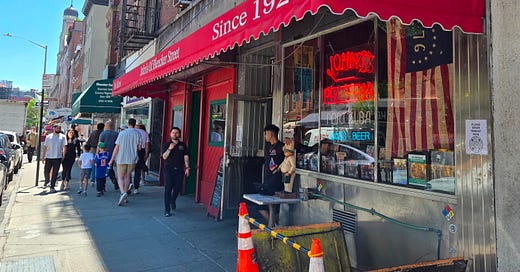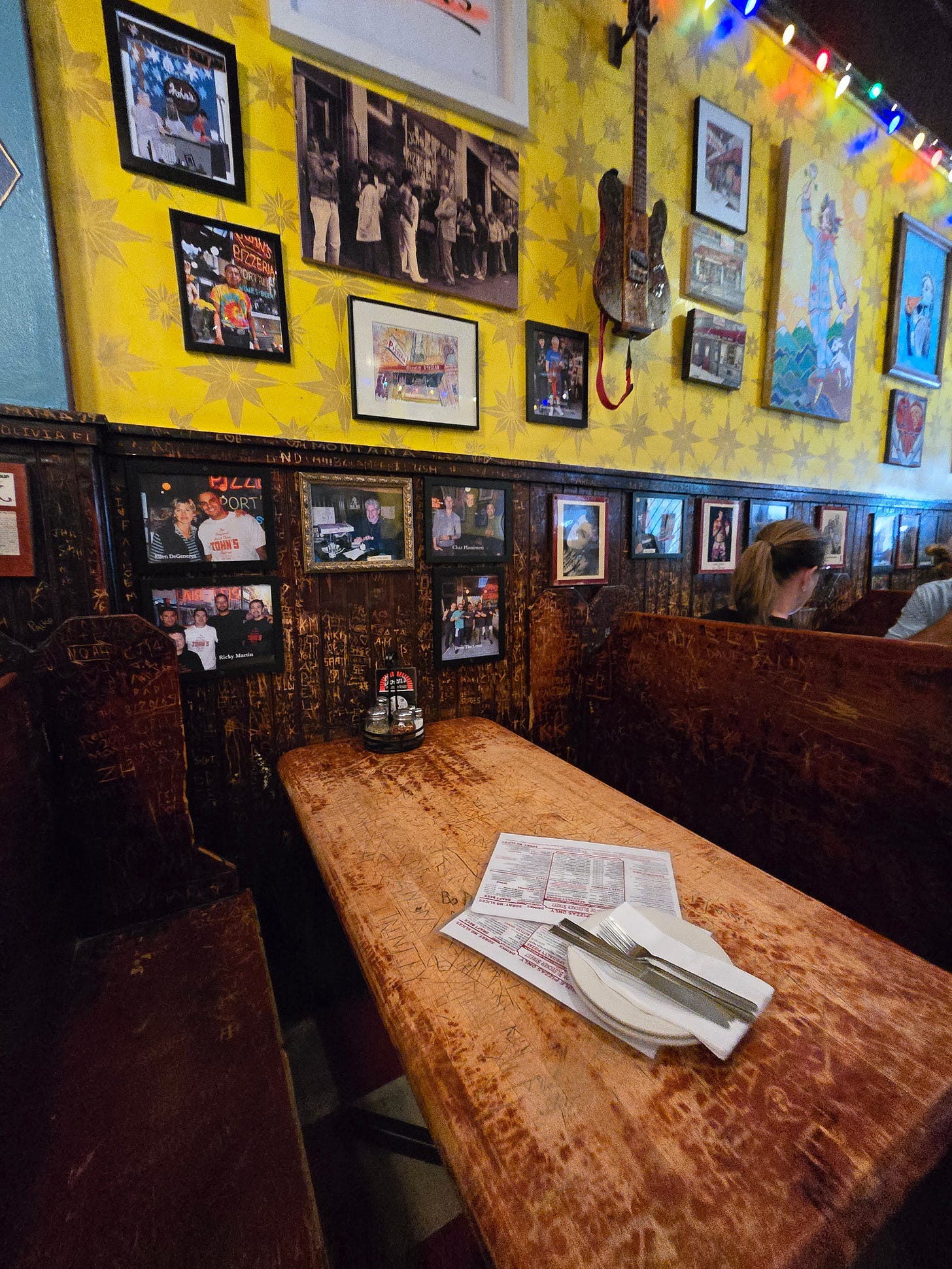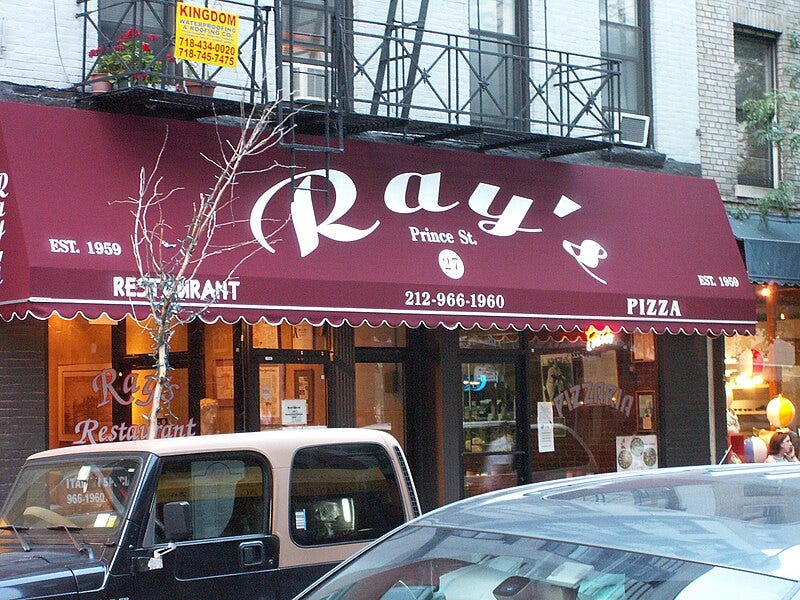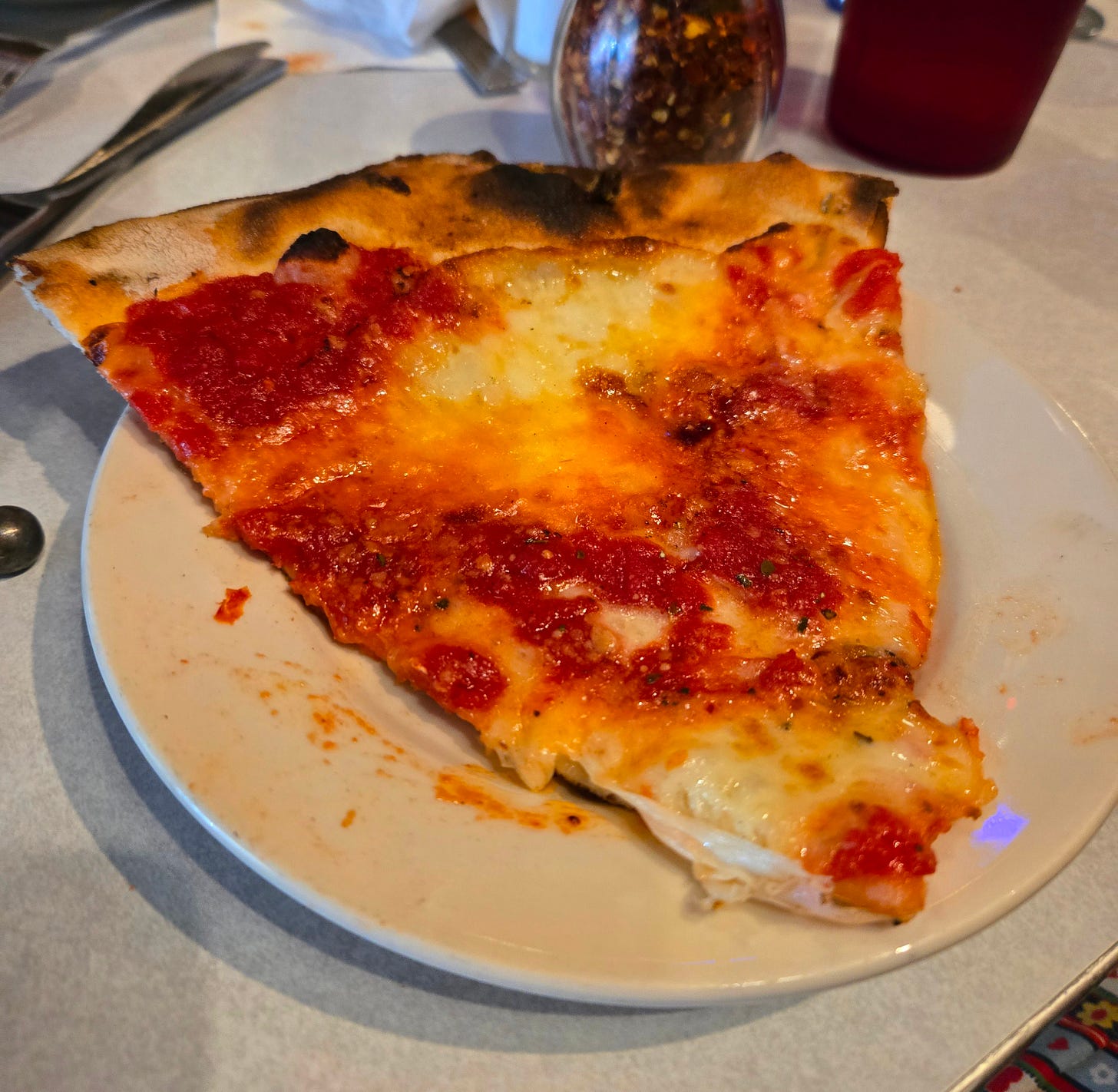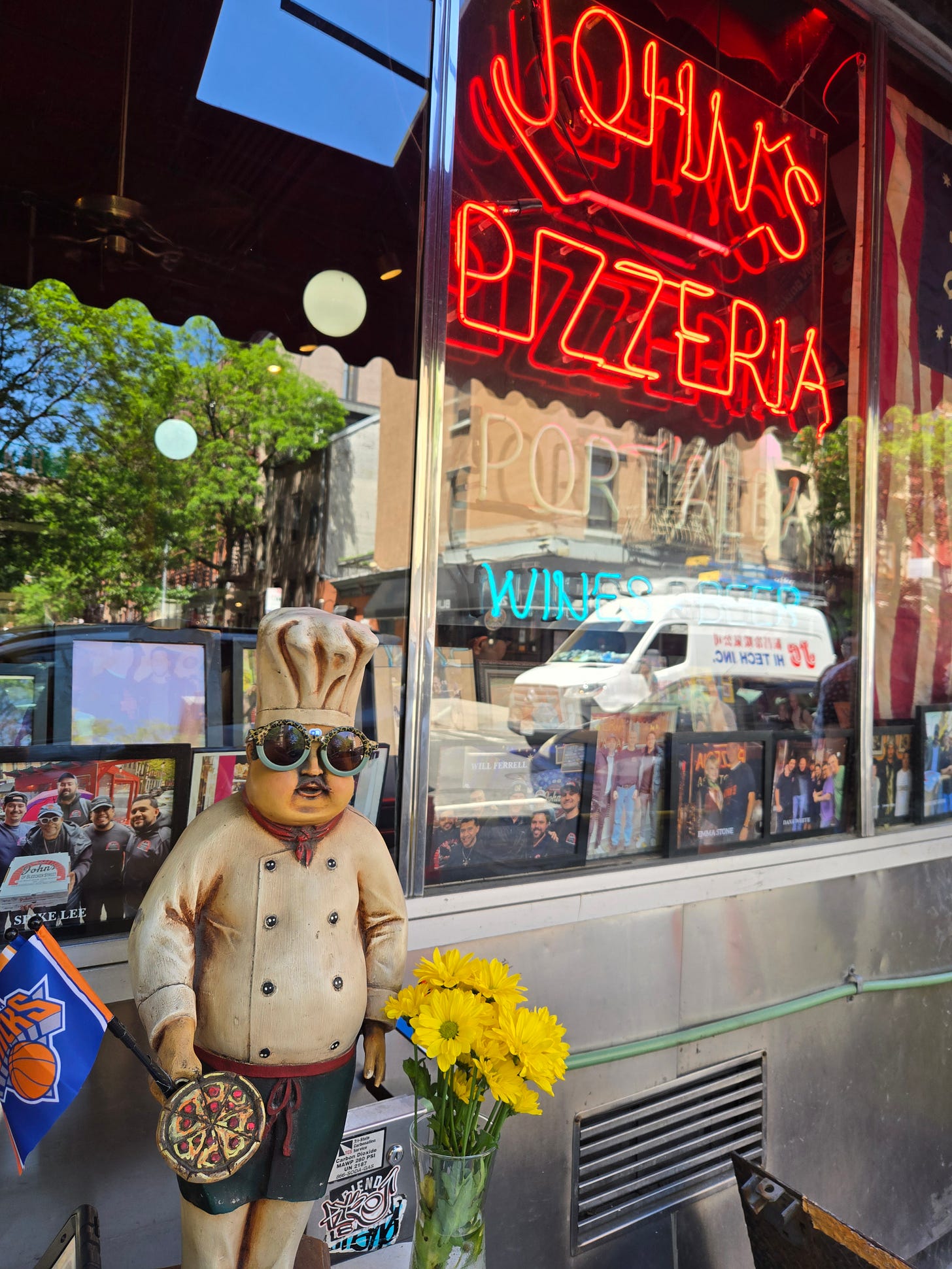If there is one dish that defines New York City more than any other, it is, most arguably, pizza. No other food is quite so symbolic of that fast-paced pedestrian culture as those little slices of heaven. As a result, there is much discourse about who has the “best” pizza in the city. And there is truly some world-class pizza in New York, whether it’s Italian-style Neapolitan pizza made by trained chefs, such as a Zero Otto Nove or whether it’s the only-in-America heft of L&B Spumoni Garden’s square slice. But there’s a problem with such a notion; true NY-style pizza is not particularly designed to be the “best” at anything. Your dollar-slice pizzaiolos are primarily concerned with having the fastest pizza around.
And that’s really the thing that makes New York’s pizza culture distinctive, the convenience of it. New York is known for pizza because it is cheap, it is fast, and it is everywhere. Pizza shops are rivaled perhaps only by Chinese takeout restaurants in their ubiquity from Staten Island to Far Rockaway. In the ecosystem of a New York neighborhood, cheap slice joints are as essential as air or water. Day or night, rain or shine, whether up in the Bronx or way down in Bay Ridge, if you are hungry, you can easily walk out your apartment door and wander practically any direction and hit a pizza place before long.
Which is why it was such a difficult prospect for me to find one, single place to write about that represented NYC pizza culture. NY-style pizza places are inherently unremarkable and utilitarian. There are hundreds, perhaps thousands of pizzerias with no aesthetic, no recognizable brand, just cheap slices and a sense of determination. This was not always the case; at one time, there was Ray’s Pizza and about a hundred different knockoffs peddling slices as if they were God’s gift to New York. It was even joked about on Seinfeld. But in the foodie age, most of the various Ray’s Pizza permutations, including the original Ray’s Pizza (not to be confused with Original Ray’s, or Famous Original Ray’s, or…), have closed up shop. I’m not really sure what happened to the Ray’s phenomenon as a whole, but perhaps it’s telling that the OG Ray’s Pizza has been replaced by the original Prince Street Pizza location.
See, for a while there, the many Ray’s of New York really did try to represent NY-style pizza as something sort of world class, something worth duping tourists over. Most of them weren’t all that great, but they tried to exist in a sort of middle ground between the two extremes we have today: unremarkable dollar pizza places on one end, and “elevated” slice joints like Prince Street on the other, who actively attempt to make something like the “best pizza in New York” (whether or not Prince Street Pizza succeeds at that is for you to decide). With the rise of both these types of establishments, perhaps there is no longer room for such a proliferation of not exactly good, but not exactly cheap places like Ray’s used to be.
Which is unfortunate; the countless “knockoff” Ray’s were a testament to the drive and creativity of the people of New York, and something that made it unique. There’s shitty pizza and trendy pizza in every city in America, but Ray’s was something special New York could claim (I have a theory that Seinfeld is at least partially to blame; when the show poked fun of something in pop culture, especially when it related to New York, it tended to become a joke in real life, which caused these things to fall quickly out of fashion, such as frozen yogurt (at least until the rise of Pinkberry in the 2000s), 8-ball jackets, and the American branches of Kenny Rogers’ Roasters).
But I digress. It was a challenge for me to decide, in this day and age, who could possibly represent the distinctly old-school kind of New York pizzeria in all its beautiful simplicity. So how about the oldest pizzeria in New York? Now I must disclaim at this point that determining the actual oldest pizzeria in New York is a mystifying task. Lombardi’s is the traditional answer, having allegedly been founded in 1905. But there is evidence that that pizzeria was operating under a different name already in the 1890s, and Lombardi would not acquire ownership of the place until 1908. The truth of the matter seems to lie with one Filippo Milone, who had a habit of founding pizzerias early in the late 19th/early 20th century, then handing them off to various business partners. Such is the story of Pizzeria Port’Alba, which eventually became John’s Pizzeria in reference to one of Milone’s business partners, John Sasso, as well as that of Lombardi’s, named after another associate of Milone’s named Gennaro Lombardi. It isn’t clear what the actual oldest pizzeria may be; whether it may still be standing, or bit the dust years ago. But there is a convincing case to be made that John’s and Lombardi’s carry on the legacy, and perhaps the closest we have to an original recipe, of the very first pizzerias in America.
Perhaps it is necessary at this point to make a distinction between the NY-style pizza, and the NY-style pizzeria. The former refers to a particular way of making pizza; namely, in the manner of a thin, leathery crust topped with a thin layer of tangy, oregano-tinged tomato sauce and an impermeable shield of melted mozzarella cheese. Toppings can be had, but the cheese slice is de rigeur. The NY-style pizzeria, on the other hand, is different. These are not dollar slice joints, but venerable neighborhood anchors that occasionally transcend into local landmarks. They typically feature a primary, charismatic pizza maker/owner who, in an idealized sort of way, is a gruff but loveable and hard-working local character, who might give you a hard time for taking too long to order, but conversely might hand out lollipops to neighborhood children. Now of course, I’m describing something of a caricature, but you get the idea. It’s not all that different from the depiction of the pizzeria in Do The Right Thing, complex racial dynamics included, though that is a discussion for another post.
So perhaps John’s is representative of the NY-style pizzeria, and that’s good, because it isn’t exactly representative of the NY-style slice. That’s because John’s doesn’t do slices; it’s whole-pie only. Which marks another important distinction. Places that have been around as long as John’s can often attribute their longevity to a certain respect they have for the pie. The reason I’m not writing about Lombardi’s instead of John’s is because Lombardi’s is widely recognized as something of a tourist trap. Sure, they’ve still got that coal-fired oven, which does put them a notch or two above your average pizzeria. But its location at the edge of Little Italy marks it as a place that is mostly coasting on a certain, perhaps fabricated, notoriety. I’ve had their pizza before. It’s alright. But John’s is different.
You see, John’s is widely respected for its pies. Perhaps these days it’s something of a tourist destination, something I attribute to the propensity of internet hype-men to overexaggerate the importance of certain “locals-only” type establishments. Influencers like to take certain places and say “only tourists go to X place, REAL New Yorkers go to Y place.” But that wasn’t always the case, and the long lines that you typically have to endure to try a pie are a somewhat recent phenomenon. For much of its existence, it was just an extremely solid neighborhood pizzeria, back before its particular neighborhood was swamped with wannabe Gen Z Carrie Bradshaws. Like I said, the respect its pizza makers had for their craft spoke for itself. John’s would routinely draw praise from the likes of The New York Times for its dogged commitment to tradition, though it tended to be overshadowed by the Lombardis and the Rays of the world. And that respect is still evident in every pizza that comes out of that big brick oven in the ancillary dining room (which I imagine used to be the primary kitchen).
Luckily on my arrival, there was no line, so I was seated immediately, though the house quickly filled its seats over the course of my meal, and a line wrapped around the corner by the time I made my exit. The staff are, despite any notoriety, warm and welcoming, ushering me inside with the aplomb due an old family friend, waved past the front entrance to a secondary dining room located adjacent to the pizza oven like it’s some kind of secret.
Perhaps the first thing you notice about John’s is the dark wooden booths that comprise most of the seating. They’ve carved with decades’ worth of names, boasts, and initials circled by little Cupid’s-arrow hearts. History is literally etched into every available wooden surface, even the walls in the hallway leading to the bathrooms. But that doesn’t mean John’s is entirely stuck in the past. Much of the wallspace in the second dining room features odd, postmodern Mexican sugar skull designs, as well as contemporary ephemera like special edition John’s Pizzeria Nike Air Force 1’s. Again, the influence of the internet age is apparent here, though it is skillfully blended with a respect for tradition. The primary dining room features pretty tasteful murals of a cityscape and an Italian grotto, along with more wood paneling.
Now as for the pizza itself, you can pick your pie and its toppings, but the Sasso is the ur-pizza here at John’s, featuring nothing more than parmigiano, oregano, and black pepper as toppings. Get this one. You wait about 15 minutes before the pie emerges from the oven and is brought directly to your table on one of those stainless steel pizza stands. A pie like this deserves its own pedestal, after all.
For me, when it comes to this pizza, it was love at first sight. The oozy, transformative landscape formed by the mingling of cheese and sauce was undeniably alluring. The slight, gentle char on the crust told me of the acute attention to detail paid by the pizzamakers. Picking up a slice, there are little spots, as fine and evenly spaced as a Dalmatian pup, on the underside that tell of a perfectly even cook. Just the right amount of grease dribbles along its surface; enough to impart a distinct flavor, but not enough to make it feel greasy, or to ooze out the back when you fold it up for a bite.
Speaking of which, the fold is a vital technique for New York pizza. If you can’t fold it, that’s bad news, which may be why New Yorkers have such enmity for Chicago-style: it’s too thick to fold. John’s pizza has a thin, foldable crust, but it’s not as leathery as your typical slice joint pizza. It’s got a distinct crisp to its crust, audible but not so crispy it cuts the roof of your mouth or becomes unfoldable. It’s pleasant, a nice textural counterpoint to the oozy cheese.
But perhaps the component that most sets a good pizza apart from a mediocre one is the sauce. And the sauce at John’s is practically good enough to drink, or even sip thoughtfully from a tasting glass. It’s slightly, slightly sweet, with big garlicky notes and a nice tomato tang. And they ladle it on quite judiciously, such that only the most sensitive palates are likely to experience acid reflux. Truly, it is a great pie, one that is eminently worthy of all the praise it gets. Even if that means one has to brave epic lines for what is, at its heart, a good neighborhood joint like so many across the city.
And in that sense, John’s is not unique. There are places that are just as good, and nearly as steeped in history, as John’s to be found in all five boroughs. But John’s is indeed uniquely representative of this style of place, partly because its pizza is indeed commendable, but also partly due to being quite a bit older than almost any other pizzeria, as well as just having that X-factor that makes these old places one of a kind. Sure, there might be older places, or better pizzas, but nobody, nobody can capture that singular feel of walking into John’s and letting your eyes wash over the ancient wood carved with the names of countless patrons. You cannot create that whole-cloth, it must be authentically lived. And in that sense it captures something vital about New York as a whole: you can see, in the skyscrapers and the worn facades of the brownstones and the buzzing neon signs that blink in the misty night, you see evidence of the countless other New Yorkers who have carved out a niche for themselves among the many millions. And you can see it too in the names carved into the booths at John’s. Care to join them?


